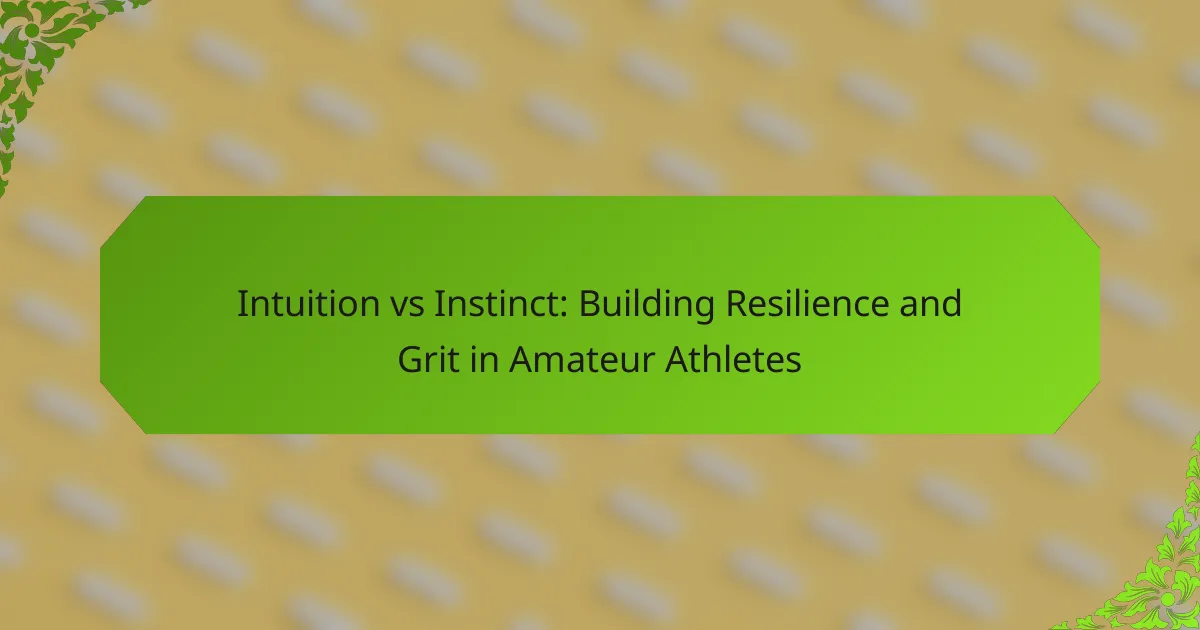Changing seasons significantly impact the resilience and grit of amateur athletes in their training. Seasonal variations affect training conditions, motivation, and recovery strategies. Athletes must adapt to challenges such as cold winter weather, summer heat, and spring allergies. Implementing mental conditioning, goal setting, and adaptive training methods can enhance their performance and mental strength throughout the year.

How do changing seasons impact resilience in amateur athletes?
Changing seasons significantly impact resilience and grit in amateur athletes’ training. Seasonal variations influence training conditions, motivation, and recovery strategies.
In winter, cold weather may limit outdoor training, compelling athletes to adapt their routines. This adaptation fosters mental toughness, enhancing resilience. Conversely, summer heat can lead to fatigue, requiring athletes to develop grit to maintain performance.
Research indicates that athletes who train in diverse conditions exhibit higher resilience levels. For instance, those who train in both hot and cold conditions adapt better psychologically and physically.
Additionally, seasonal transitions can affect mental health. Spring and autumn often bring increased motivation, while winter may lead to seasonal affective disorder. Athletes must cultivate strategies to counter these fluctuations, reinforcing their resilience and grit throughout the year.
What are the psychological effects of seasonal changes on training?
Seasonal changes can significantly impact resilience and grit in amateur athletes’ training. Variations in weather and daylight affect motivation, mood, and overall performance.
The winter months may lead to decreased motivation due to shorter days and colder temperatures, resulting in lower training consistency. Conversely, spring and summer often boost energy levels and encourage outdoor training, enhancing resilience.
Research indicates that athletes who adapt their training routines to seasonal changes can develop greater mental toughness. For instance, training indoors during winter can foster discipline and grit, while outdoor training in favorable conditions can enhance enjoyment and engagement.
Ultimately, understanding and adapting to seasonal psychological effects can help amateur athletes maintain a consistent training regimen and improve overall performance.
How does weather variability influence grit in athletes?
Weather variability significantly impacts resilience and grit in amateur athletes’ training. Seasonal changes can present challenges that test mental toughness, adaptability, and commitment.
Cold weather conditions can lead to increased training difficulty, requiring athletes to develop strategies to maintain motivation. For instance, shorter daylight hours may affect training schedules, pushing athletes to adapt their routines.
Conversely, warmer weather can enhance outdoor training opportunities but may also introduce risks like dehydration or heat-related illnesses. Athletes must cultivate resilience to handle these fluctuations effectively.
Research indicates that athletes who embrace seasonal challenges often report higher levels of grit, as they learn to push through discomfort and uncertainty. This adaptability can lead to improved performance and mental fortitude over time.

What universal resilience practices can athletes adopt year-round?
Athletes can adopt universal resilience practices such as mental conditioning, goal setting, and adaptive training methods year-round. These practices help maintain grit and adaptability through seasonal changes.
Mental conditioning techniques, like visualization and positive self-talk, enhance focus and perseverance. Goal setting, with specific, measurable objectives, provides direction and motivation throughout the year. Adaptive training methods, including cross-training and varied workout environments, build physical and mental resilience against seasonal challenges.
By integrating these practices, athletes can sustain their performance and mental strength, regardless of external conditions.
How can goal-setting enhance resilience during seasonal transitions?
Goal-setting enhances resilience during seasonal transitions by providing structure and motivation. Clear goals help athletes maintain focus, adapt training plans, and track progress, fostering a sense of achievement. This approach builds mental toughness, enabling athletes to face challenges posed by changing seasons. Research indicates that goal-setting can improve performance and reduce anxiety, crucial during periods of adjustment. By setting specific, measurable targets, athletes can cultivate grit and perseverance, essential for thriving in fluctuating conditions.
What role does community support play in building grit?
Community support significantly enhances grit in amateur athletes by providing emotional encouragement and practical resources. This support fosters resilience during training, especially as seasons change. For instance, athletes who engage with supportive peers are more likely to persevere through challenging weather conditions. Additionally, shared experiences within a community can reinforce commitment to training goals, making athletes more adaptable. Ultimately, a strong community serves as a vital attribute in developing the grit necessary for sustained athletic performance.

What unique challenges do different seasons present for training?
Different seasons present unique challenges for training that affect resilience and grit in amateur athletes. Winter often brings harsh weather, limiting outdoor training and requiring adjustments in routine. Spring may introduce allergies, impacting stamina and focus. Summer heat can lead to dehydration and fatigue, necessitating careful hydration strategies. Fall often presents a transition period, where athletes must adapt to changing temperatures and potential injuries from increased activity. Each season demands mental and physical adaptability, shaping an athlete’s resilience.
How can winter conditions affect training consistency?
Winter conditions can significantly disrupt training consistency for amateur athletes. Cold temperatures, snow, and ice create obstacles that can limit outdoor training opportunities.
Athletes may face increased risk of injury due to slippery surfaces, leading to hesitance in training. Additionally, shorter daylight hours can affect motivation and schedule adherence.
To maintain resilience and grit, athletes should adapt their training routines, incorporating indoor workouts or adjusting schedules to optimize training times.
Utilizing proper gear and safety measures can help mitigate risks, ensuring that training remains consistent despite winter challenges.
What adjustments should be made for summer training intensity?
To adjust summer training intensity, athletes should increase hydration, modify workout times, and incorporate heat acclimatization strategies. These changes help maintain performance and prevent heat-related illnesses.
1. Increase hydration: Ensure adequate fluid intake before, during, and after workouts to combat heat stress.
2. Modify workout times: Schedule training sessions during cooler parts of the day, such as early morning or late evening.
3. Incorporate heat acclimatization: Gradually increase exposure to heat conditions to enhance tolerance and performance.
Adjusting these factors can optimize training effectiveness while promoting athlete safety.
How to stay motivated during off-peak seasons?
Staying motivated during off-peak seasons requires strategic focus and adaptability. Setting specific training goals helps maintain purpose, while varying workout routines prevents monotony. Establishing a supportive community fosters accountability and encouragement, essential for resilience in amateur athletes. Incorporating mental training techniques can enhance grit, enabling athletes to push through seasonal challenges.

What rare resilience strategies can athletes implement?
Athletes can implement rare resilience strategies such as adaptive training, mental visualization, and seasonal goal adjustment. These methods enhance grit and adaptability to seasonal changes. Adaptive training involves varying intensity and focus based on weather conditions, which builds mental toughness. Mental visualization helps athletes prepare for challenges they may face during different seasons. Seasonal goal adjustment allows athletes to set realistic targets that align with environmental factors, fostering a resilient mindset.
How do seasonal sports-specific training adaptations work?
Seasonal sports-specific training adaptations enhance resilience and grit in amateur athletes by promoting physical and mental adaptability. Changes in weather and training conditions require athletes to adjust their routines, fostering resilience through overcoming challenges. For instance, winter training may emphasize strength and endurance, while summer focuses on speed and agility. These adaptations cultivate grit by encouraging persistence in the face of varying difficulties, ultimately improving overall performance.
What are the benefits of cross-training in different seasons?
Cross-training in different seasons enhances resilience and grit in amateur athletes by promoting adaptability and reducing injury risk. Seasonal variation in training conditions challenges athletes, building mental toughness and physical versatility. For example, winter training may focus on strength while summer emphasizes endurance. This cross-training approach fosters a well-rounded skill set, ultimately improving overall performance.

How can amateur athletes maintain grit through seasonal fluctuations?
Amateur athletes can maintain grit through seasonal fluctuations by adapting their training and mindset. Emphasizing flexibility in training routines helps athletes cope with changing conditions. Setting specific goals for each season enhances focus and motivation.
Incorporating cross-training can prevent burnout and injuries while maintaining engagement. Building a supportive community fosters resilience, providing encouragement during challenging periods. Regularly reflecting on progress cultivates a growth mindset, reinforcing determination.
Athletes should also prioritize recovery and self-care, as these are critical for sustaining grit. Engaging in mindfulness practices can further enhance mental toughness, enabling athletes to navigate seasonal challenges effectively.
What are the best practices for adapting training to seasonal changes?
To adapt training for seasonal changes, focus on adjusting intensity, volume, and recovery strategies. Tailor workouts to align with weather conditions, ensuring athletes remain engaged and motivated.
In colder months, emphasize indoor training and cross-training to maintain fitness levels. For warmer seasons, incorporate outdoor activities that enhance endurance and resilience.
Monitor athletes’ responses to these changes, adjusting plans based on their feedback and performance metrics. This approach fosters grit and adaptability, essential traits for amateur athletes.
Additionally, consider nutrition adjustments to support energy needs throughout the year. Seasonal foods can enhance recovery and overall health, contributing to sustained athletic performance.
What common mistakes should athletes avoid during seasonal transitions?
Athletes should avoid neglecting proper warm-ups, ignoring hydration needs, and failing to adjust training intensity during seasonal transitions. These mistakes can hinder resilience and grit development. Additionally, athletes should not overlook the importance of mental preparation, as adapting to changing conditions impacts performance. Prioritizing recovery and nutrition is crucial to maintain optimal training outcomes.
How can athletes leverage seasonal changes for personal growth?
Athletes can leverage seasonal changes to enhance resilience and grit through tailored training strategies. Seasonal variations impact training intensity, recovery, and mental focus, allowing athletes to adapt and grow.
During winter, athletes may focus on indoor training, emphasizing strength and conditioning. This can build mental toughness as they face the challenge of limited outdoor options. In spring, athletes can shift to outdoor activities, improving endurance and adapting to varying weather conditions.
Summer provides opportunities for high-intensity training in diverse environments, fostering adaptability. Athletes can embrace the heat, developing grit through challenging workouts. Fall often signals a return to structured routines, enhancing focus and discipline in preparation for competitions.
By aligning training with seasonal changes, athletes cultivate resilience, equipping themselves to face diverse challenges throughout the year.



